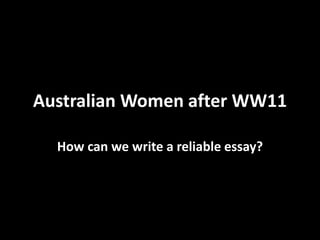
Lesson plan powerpoint
- 1. Australian Women after WW11 How can we write a reliable essay?
- 2. What is a source?
- 3. What is a source? • Sources are pieces of information we can use to help us understand certain periods of time. • Like a detective, we, and fellow historians have to piece together a puzzle of what happened in the past. The best way to do this is to find information left for us from a number of different ‘sources’. • Sources can range from; – Journal entries – Newspaper clippings – Comics – Illustrations, – Speeches, – Books, – Articles – Anything written, drawn or said about the period that is being studied.
- 4. Are there different kind of sources?
- 5. Are there different kind of sources? PRIMARY SOURCE • A primary source is a specific source, which has been published DURING the period that is being studied. • Primary sources are a good reference as it directly reflects the thoughts, opinions and ideology of the period. It gives a good insight on what was going on at that time. SECONDARY SOURCE • A secondary source is a specific source, which has been published AFTER the period that is being studied. • Secondary sources are a good reference as it can put certain events and people into context of the overall period. • It is able to look at more than one idea/thought and create an overall comparison.
- 6. What would we use sources for?
- 7. What would we use sources for? • In history, using sources are crucial to develop a sound understanding of certain periods in time, especially certain events and people. • We can use sources to help us learn about events and people, and we can also use sources to help us illustrate a certain point we might be explaining. • HOWEVER you cannot use a source as your own idea. You must always reference the source.
- 8. Why might it be important to use sources?
- 9. Why might it be important to use sources? • Overall, sources, primary and secondary, are crucial in history to aid in our ability to learn but also to help us evaluate history. • When writing an essay, it is important to have an added perspective (from a source), which is always referred as reliable. • In making our essays reliable, we are able to express our points more clearly and persuasively.
- 10. Primary sources • Primary sources are very important to use when studying any kind of history. • To learn about events and people, we use sources to understand the history and the ideology of the period. • Primary sources give us a direct insight into the thoughts of individuals and also an overall picture of events and people, if the source is from somewhere such as a newspaper.
- 11. Secondary sources • Secondary sources are also very important to use when studying any kind of history. • Secondary sources are generally written and published by historians and academics who have thoroughly researched (using primary and secondary sources) an idea, event or person in history and given us a detailed account. • This helps us learn in depth about different ideas surrounding the period we are studying.
- 12. Where might we find sources?
- 13. Where might we find sources? • Primary – Old newspapers – Journal articles – Text books – Sources from books • • Secondary – The library – many, many books on many, many different topics (non-fiction of course!!!) – Current newspapers – see if you can find any present articles that refer to something in the past CAN YOU THINK OF ANYWHERE ELSE YOU MIGHT FIND SOURCES?
- 14. Can you tell which one is a primary source and which one is a secondary source?
- 15. Is this a primary or secondary source? Hughes, K Contemporary Australia; Feminism Two Addison Wesley Longman Australia Pty Ltd, Melbourne 1994, PG 322
- 16. Is this a primary or secondary source? *Don’t forget – Always reference your source! Join us in a Victory job, Maurice Bramley, 1943
- 17. Is this a primary or secondary source?
- 18. How to tell the difference between a primary source and a secondary source • Sometimes it’s difficult to tell the difference between sources, especially when it might be a quote or a block of writing. • A lot of the time a primary source will be written in the first person, for example “I think…”, like the third example. • A lot of the time a secondary source will be written in the third person, for example “The war changed the lives of many people….”. • Most images or illustrations are a primary source. It is quite rare to find a secondary source as a visual in history
- 19. So now we know what primary sources and secondary sources are how can we use them…
- 20. What does this source tell us about the opinions of women in the war? • Firstly, is this a primary or secondary source? • Does this depict a positive or negative attitude towards women? • What can we learn about the opinions surrounding women in the war during this period, as depicted by this The Bulletin, 1939-1945 illustration?
- 21. How can we understand and make use of sources? • When understanding sources it is important to go through a number of questions; – What are the main points? – What is the context of the source? – Look for any kind of bias in the source (especially if it is a primary souce) – What perspective is it? i.e who is saying/doing what? – Always ask “WHY” to all these questions
- 22. Take 5 minutes to analyse this source Don’t forget to go through all the points on making sense of sources
